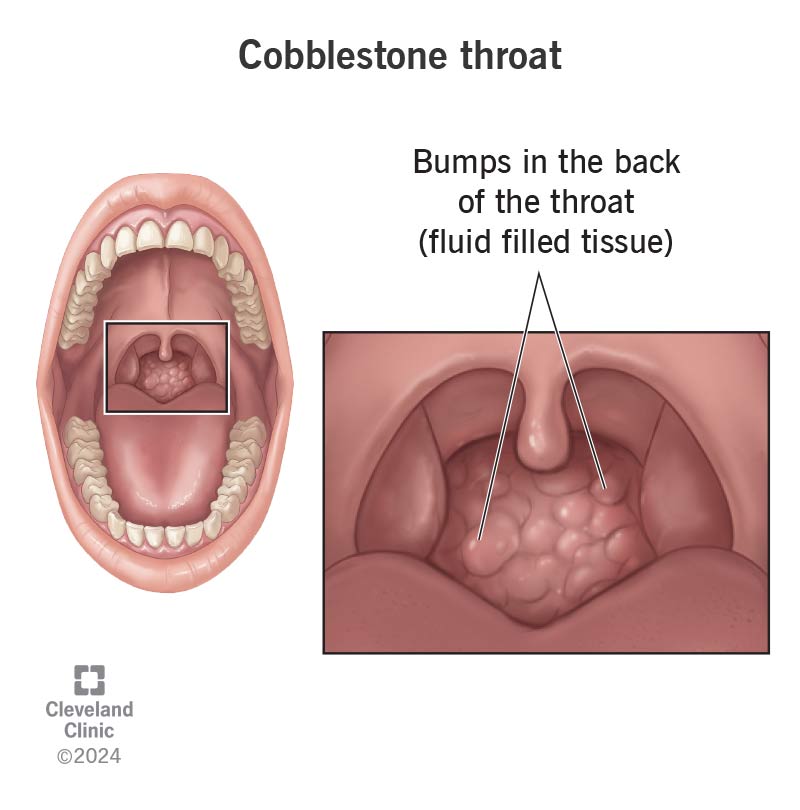Cobblestone throat refers to bumps on the back of your throat. It’s a symptom of many conditions like allergies, postnasal drip and sinus infections. Cobblestone throat isn’t dangerous. The pebble-like bumps look worse than they are. The cobblestoning in your throat goes away once the cause of irritation resolves.
Advertisement
Cleveland Clinic is a non-profit academic medical center. Advertising on our site helps support our mission. We do not endorse non-Cleveland Clinic products or services. Policy

Cobblestone throat involves having inflammation that causes bumps in the back of your throat. It’s a symptom of several conditions like allergies, postnasal drip and sore throat (pharyngitis).
Advertisement
Cleveland Clinic is a non-profit academic medical center. Advertising on our site helps support our mission. We do not endorse non-Cleveland Clinic products or services. Policy
Many people panic when they notice the raised tissue, thinking that the bumps may be cancerous growths. But the bumps are harmless. The “cobblestones” you see in the mirror are fluid-filled tissue that temporarily forms in response to an infection, allergen (something you’re allergic to) or another irritant.
A healthy immune system is good at getting rid of germs or irritants that can cause cobblestone throat. The bumps go away once the cause resolves.
You can tell if you have cobblestone throat by its name — bumps in the back of your throat that resemble cobblestones or pebbles. The bumps may look discolored, irritated or inflamed. You’ll likely have a sore throat, too.
You might also have:
Cobblestone throat isn’t contagious, but it may result from a contagious condition. For example, you can pass along a viral infection causing your throat irritation (like the flu) or a bacterial infection (like strep throat). Both viruses and bacteria are contagious and can lead to cobblestone throat. Other causes, like allergies or acid reflux, aren’t contagious. It depends.
Advertisement
The person who contracted the infection may or may not develop cobblestone throat, even if they got the germ from someone who does have it. It depends on each person’s immune response and how irritated their throat gets.
The bumps associated with cobblestone throat appear when your tonsils and adenoids become irritated and swollen. Your tonsils and adenoids prevent germs from entering your respiratory passages. Mucus coats these tissues and your passageways to further trap germs.
Sometimes, invaders like viruses bypass these defenses and trigger your body’s immune response. When this happens, the tissue in your throat swells and mucus production increases. The increased mucus helps with flushing out germs. The mucus thickens and trickles down your throat (postnasal drip), irritating your tonsils and adenoids. The bumps in your throat are a sign of this irritation.
You can get cobblestoning in your throat from things like:
COVID-19 is caused by a virus, which means cobblestone throat may result from an infection. Still, cobblestone throat isn’t a common COVID-19 symptom. Common respiratory infections, like the flu or a cold, are more likely causes.
Many people with cobblestone throat worry that the bumps are cancerous lumps or signs of an HPV infection that may become throat cancer. But cobblestone throat isn’t related to high-risk strains of HPV or throat cancer.
With cobblestone throat, HPV and oral cancer, you may have a sore throat. But neither an oral HPV infection nor throat cancer produces the characteristic bumps associated with cobblestone throat. You’re more likely to notice a lump in your neck or a red or white patch in your throat if you have a high-risk strain of HPV. Often, HPV doesn’t produce any symptoms.
A sore throat often — but not always — accompanies cobblestone throat. The usual causes may be to blame even if your throat doesn’t hurt (like colds, the flu or allergies). It’s also possible that the raised tissue in your throat is a sign of another condition. If your bumps don’t disappear within a week or two, see a healthcare provider to get an accurate diagnosis.
You can get rid of cobblestone throat by eliminating what’s causing inflammation and postnasal drip. Often, your immune system can cure viral and bacterial infections on its own. If not, your healthcare provider can recommend or prescribe medications that can help.
Advertisement
You can treat cobblestone throat by:
The bumps should disappear within a week or two if a cold or the flu caused the irritation. Cobblestone throat that doesn’t go away may be related to acid reflux, allergies or a nastier germ that your body is having trouble fighting. If the bumps persist, see a healthcare provider.
Consider the following tips to reduce your risk for cobblestone throat:
Schedule an appointment with a healthcare provider if:
Advertisement
See a healthcare provider immediately if you’re caring for an infant you suspect has cobblestone throat.
It can be alarming to notice cobblestoning in your throat when you look in the mirror, but don’t worry. Think of the bumps as a sign that your immune system is doing what it’s supposed to do — fighting invaders like germs and allergens. The bumps often disappear within a few weeks along with other common signs like a sore throat. In the meantime, home remedies like gargling saltwater, honey, humidifiers and cough drops can help manage symptoms.
Advertisement
Cleveland Clinic’s primary care providers offer lifelong medical care. From sinus infections and high blood pressure to preventive screening, we’re here for you.

Last reviewed on 11/26/2024.
Learn more about the Health Library and our editorial process.